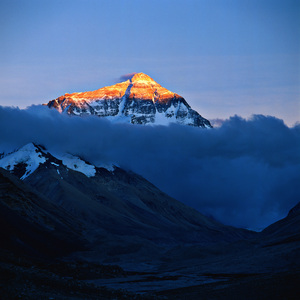Documentary films about Mt. Everest often sound like a catalog of mountaineering horror movies. Everest: The Death Zone, Storm Over Everest, Into Thin Air: Death on Everest, Into the Thin Air of Everest: Mountain of Dreams, Mountain of Doom. As filmmakers like David Breashears know, documenting Mt. Everest is almost always shadowed by death. Whether its the remains of climbers frozen into the mountainside or the deteriorating effects of altitude above 23,000 feet (the death zone).
Breashears is an important figure in documenting Mt. Everest, from transmitting the first live pictures from Mt. Everest’s summit to leading the IMAX film crew in Everest. The very crew filming during the pivotal 1996 Disaster on Everest, where 8 people (15 total that season) died in a single day on the mountain. The tragedy was made popular by Jon Krakauer’s bestselling book, Into Thin Air: A Personal Account of the Mt. Everest Disaster. It was “pivotal” in that the disaster brought the fatal hazards of climbing Everest into mainstream thought and spurred a number of documentaries about the deadly ascent.
The Tibetans call her Chomolungma (Saint Mother), the Nepalese call her Sagarmatha (top of the world), and the British named it Everest. Since it was claimed the highest point on earth (above sea level) in 1856 by the British Surveyor General of India, Andrew Waugh, the name of his predecessor, George Everest has stuck. Over five miles into the air, Everest was originally claimed to be 29,002 feet and has since tacked on a more accurate measurement of 29,029 feet.
That fact alone makes Everest a fascination for documentarians, yet it is made dramatic by both triumphant and tragic attempts to climb it. As many mountaineers note, ascending Everest is downright unreasonable, irrational and completely insane. The altitude alone will kill you, not to mention the unpredictably deadly weather and geographic conditions threatening every step. If you are injured on the ascent above the base camps of Everest (17,000 feet), your rescue is unlikely at best.
As for most land dwellers in the thick breaths of sea level, Everest is a distant dimension of Earth. We retain little more than that it is the highest peak, first summated by the New Zealand beekeeper Edmund Hillary and the Sherpa Tenzing Norgay. Mountaineering has always been a sport associated to fatality, but since the 1996 Everest disaster, the mountain’s reputation as a death trap was sealed for adventurers and wealthy weekend warriors alike.
Understanding the physiological affects of the ascent is a good place to start when exploring a fascination with Everest. David Breashears co-produced and directed the Nova special Everest: The Death Zone in 1998. He bravely returned to Everest for the production less than two years after seeing 8 climbers succumb to the mountain in 1996. He was joined by mountaineer extraordinaire Ed Viesturs, who starred in the IMAX film Everest with Breashears, during the 96 disaster. As of today, Breashears has summated Everest five times, and Viesturs seven. In Everest: the Death Zone, with Jodie Foster narrating, Breashears and Viesturs guide newcomer Peter Hackett to the summit.
The purpose of the NOVA special is to gage the physiological affects of altitude on climbers. During their ascent the three climbers radio back to base camp, giving readings on their blood-oxygen levels, and conducting simple mental tests. Riddles and simple brain teasers may be tough enough for some, but imagine trying it at 27,000, short of breath in bone chilling temperatures. The climbers make light of fumbling simple sentence structure, but when the results weigh in, actual brain damage is not far off. Seeing NOVA’s scientific spin on climbing Everest will really put other documentaries and books into perspective.
With that fundamental understanding, you will be tempted to pursue the holy grail of Everest stories; Jon Krakauer’s Into Thin Air. You can cheat this tome of a document and see the made for TV adaptation, Into Thin Air: Death on Everest (1997), but it’s just not worth it. The film adaptation of Krakauer’s gripping account is a complete hack of the events, and reaches the depth of a hallmark commercial. Most fictionalized accounts of such horrific events would tip the scale of tragedy, but the film is a disappointment at best, bordering on insulting. The better route is to get fully engrossed in Krakauer’s book and then get treated to another PBS foray.
David Breashears returned to Everest again in 2008 with PBS Frontline to produce, Storm Over Everest. The documentary has all the right elements; wide-eyed interviewees giving first hand details, subtle reenactments of blizzards in the night, and a Philip Glass soundtrack to boot. Breashears makes his presence known in the film, but gives the spotlight to climbers who made it off the mountain. Waving limbs frozen off from frostbite with tearful memories retold, it is the perfect compliment to reading Krakauer’s book.
Yet the most fascinating part of Frontline’s Storm Over Everest, is that Jon Krakauer is completely omitted from retelling the 1996 Disaster. His wasn’t interviewed, his name was never mentioned and he was only vaguely referenced as “one of the last people to leave the camp.” This is in reference to Beck Weathers, a climber left for dead on Everest during the disaster. In Krakauer’s account from Into Thin Air, he heard Weathers left in his tent while the survivors made their descent after a night of hell. In the Frontline documentary Krakauer is only referred to as “someone.”
Whether this is an intentional omission is something behind the scenes of recounting such a tumultuous event. Krakauer’s original article in Outside magazine and subsequent bestselling book, Into Thin Air, may have burned a few climbers worse than frostbite. If you want to avoid the drama all together and get captured by the shear magnitude of the mountain, then IMAX’s Everest is the way to go. While it’s no longer on the giant screen, renting the short 44 minute documentary captures an essence. With Liam Neeson narrating, the David Breashears cinematography reaches new heights and only mentions the 1996 disaster in memoriam, not detail.
Perhaps one of the most comprehensive documentaries on Everest is, Into the Thin Air of Everest: Mountain of Dreams, Mountain of Doom. The filmmaking itself is dated, and at times it sounds like an 80s Ski movie soundtrack, but informative nonetheless. The earlier documentary about Everest included on the DVD has priceless footage of Hillary and Norgay. Most notably, it is one of the few documentaries that go in depth about Sherpa culture, a topic sorely lacking when it comes to Everest films.
Some other notable films about Everest to check out; Touch the Top of the World, an autobiographical film about Erik Weihenmayer, a blind man who summated Everest, also featuring Weihenmayer is the documentary, Blindsight, about a group of blind teenagers who follow in his footsteps…there are over 40 entries on IMDB that have Everest in their title. It’s apparent that Everest will continue to capture our imagination as long as it reigns as the highest point on Earth. Scientists give varying arguments that Everest is either shrinking or growing, but geologically speaking it will be a long time until another peak claims the prize of highest.



